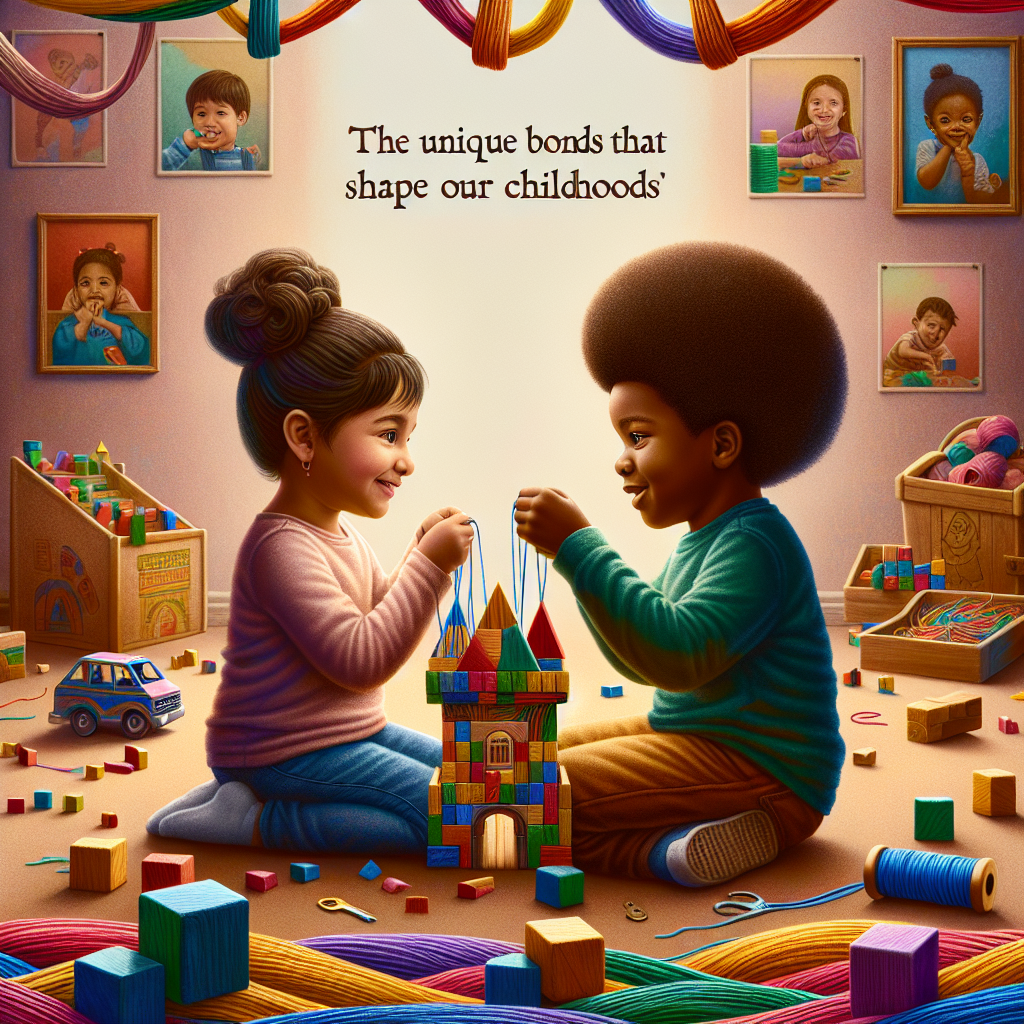
Introduction
Imagine a world where laughter echoes through shared hallways, secrets are whispered under blankets, and every nudge, shove, and playful feud creates a lifetime of memories. This quintessential childhood experience is often defined by one significant relationship: that with our siblings. The concept of Sibling Synergy: The Unique Bonds that Shape Our Childhoods encompasses a rich tapestry of shared experiences, rivalries, and collaborations that mold our formative years. These connections are not just mere familial ties; they foster emotional resilience, social skills, and lifelong relationships.
As we dive deeper into the intricacies of sibling synergy, we’ll unravel how these bonds influence our identities and relationships outside of the family unit, shaping not just childhoods, but entire lives.
The Psychological Underpinnings of Sibling Relationships
The Developmental Impact of Sibling Bonds
Research has shown that siblings often serve as our first friends and partners in crime. According to a study published in the Journal of Family Psychology, children with siblings exhibit enhanced social cognition. They learn to navigate complex social dynamics through their interactions, thereby impacting their emotional intelligence.
Table 1: Psychological Benefits of Sibling Relationships
| Benefit | Description |
|---|---|
| Enhanced Social Skills | Siblings teach conflict resolution and empathy. |
| Emotional Support | They provide a buffer against loneliness. |
| Shared Experiences | These promote bonding through mutual memories. |
| Improved Communication Skills | Regular communication fosters better dialogue skills. |
The Role of Rivalry and Competition
The fierce rivalry among siblings can seem destructive, yet it often plays a crucial role in character development. A competitive environment encourages resilience and determination. Award-winning psychologist Dr. Judy Dunn found that sibling rivalry can enhance problem-solving skills, encouraging children to advocate for themselves and learn to negotiate.
Case Study: The Hudson Brothers
Take the Hudson brothers, Jake and Max, who engaged in spirited competition from a young age. They often competed over grades, sports achievements, and even in who could build the tallest Lego tower. While their rivalry was intense, it instilled in them a profound sense of perseverance. Years later, both excelled in their respective fields: Jake in academics and Max in athletics, attributing their successes to the friendly competition they cultivated during childhood.
Sibling Dynamics Through Different Family Structures
The Only Child vs. Sibling Relationships
Only children often express feelings of loneliness, as they lack the constant companionship that siblings provide. However, they frequently cultivate deep relationships with friends or cousins to fill that void. Psychological research suggests that while only children might develop unique strengths—such as independence—the absence of sibling synergy can limit their social skill development.
Case Study: The Smith Family
The Smith family offers an intriguing perspective on sibling dynamics. With three siblings, each showcased varying personalities and roles: the caretaker, the rebel, and the peacemaker. This family model enabled an environment ripe for discussing differences, sharing responsibilities, and celebrating achievements—a perfect illustration of sibling synergy in action. The bonding experience led them all to become successful adults, but perhaps more striking was their unwavering support during crisis moments—a testament to the lasting power of sibling relationships.
The Teeter-Totter of Emotions: Love and Rivalry
The Emotional Spectrum of Sibling Relationships
Siblings experience a complex array of emotions, akin to a rollercoaster ride. From jealousy to affection, the balance between love and rivalry creates a unique emotional landscape. Children learn to express their feelings, navigate conflicts, and resolve issues, a skill that translates into their adult relationships.
Case Study: The Garcia Sisters
Consider the Garcia sisters, Ana and Mia, who faced the challenges of jealousy over academic achievements. Instead of allowing these feelings to divide them, they used them as a catalyst for growth. Through open communication and teamwork, they not only improved their own skills but also developed a deep respect for each other’s strengths. Their journey highlights how sibling synergy can transform rivalry into collaboration.
The Lifelong Impact of Sibling Relationships
Building Resilient Adults
The bond forged during childhood often extends into adulthood, creating an enduring support system. A 2019 study from the American Psychological Association emphasizes that adults with strong sibling relationships often report higher levels of well-being and life satisfaction.
Table 2: Long-Term Effects of Sibling Relationships
| Age Group | Emotional Impact |
|---|---|
| Young Adults | Improved mental health and wellbeing |
| Middle Age | Increased life satisfaction |
| Older Adults | Sustained relationships and support |
Sibling Synergy in Adulthood
As adults, siblings often become confidantes, co-parents, and even partners in business. Their shared history creates a level of understanding and trust that is hard to replicate. The synergy cultivated in childhood continues to flourish, offering mutual support and encouragement in life’s challenges.
Case Study: The Thompson Brothers
The Thompson brothers, Derek and Brian, turned their childhood rivalry into a successful business partnership. Their ability to challenge and inspire each other laid the foundation for innovation in their venture. Their ongoing collaboration illustrates how sibling synergy can evolve into powerful adult relationships that drive success.
Nurturing Sibling Bonds in Today’s Families
Tips for Strengthening Sibling Relationships
Fostering strong sibling bonds requires intentional effort. Here are five actionable tips:
- Encourage Teamwork: Engage siblings in cooperative tasks to enhance their connection.
- Promote Open Communication: Create a safe space for them to express feelings without fear of judgment.
- Celebrate Individuality: Recognize and celebrate each child’s unique qualities to reduce feelings of jealousy.
- Facilitate Shared Experiences: Organize activities that promote collaboration, whether through sports, hobbies, or family outings.
- Model Healthy Conflict Resolution: Demonstrate effective ways to resolve disagreements through dialogue and understanding.
Creating a Family Culture of Love and Support
Family traditions can reinforce the significance of sibling relationships. Regular family gatherings, whether game nights or outdoor adventures, nurture the bonds between siblings and create a platform for shared memories.
Conclusion
The essence of Sibling Synergy: The Unique Bonds that Shape Our Childhoods cannot be overstated. These powerful connections serve as the building blocks for social skills, emotional resilience, and lifelong partnerships. As we embrace the rollercoaster of sibling emotions—love, rivalry, competition—we cultivate a rich tapestry of memories that shape who we ultimately become.
Encouraging connections among siblings is not just essential; it is a privilege. By investing in these relationships, we empower the next generation to foster resilience, empathy, and cooperative spirit, leaving a lasting legacy of support and love.
FAQs
1. How do sibling relationships affect emotional development?
Sibling relationships are foundational for emotional development. They teach individuals about empathy, conflict resolution, and emotional regulation throughout childhood, which translates into healthy adult relationships.
2. Can rivalry among siblings be beneficial?
Absolutely! Rivalry can foster resilience, motivation, and adaptability. It often inspires siblings to strive for excellence and understand how to handle competition constructively.
3. What influence do parents have on sibling relationships?
Parents play a crucial role in shaping sibling dynamics by modeling behavior, encouraging communication, and fostering an inclusive environment. Their approach can significantly impact how siblings interact with each other.
4. Do sibling bonds change as we grow older?
Yes, they often evolve. While younger siblings may engage in rivalry, adult relationships tend to rely more on mutual support and understanding, often becoming deep emotional connections.
5. Can adult siblings mend fractured relationships?
Yes, with open communication and a willingness to confront past grievances, adult siblings can repair and strengthen their relationships. Acknowledging shared history is vital for rebuilding trust and connection.
Through this exploration of Sibling Synergy: The Unique Bonds that Shape Our Childhoods, we hope to inspire readers to foster and cherish these invaluable relationships, ensuring they continue to thrive for generations to come.















